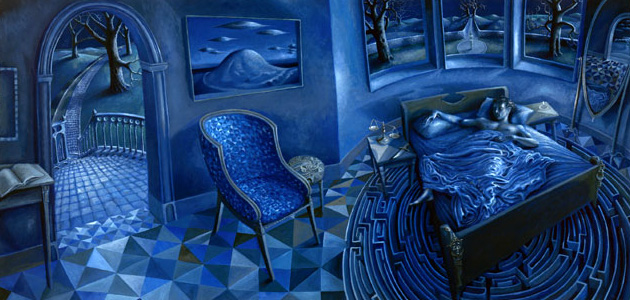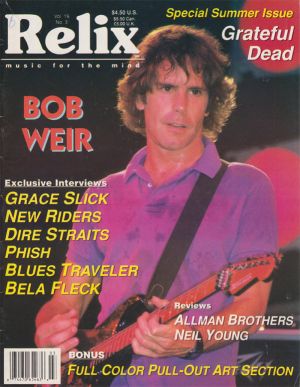Fast Enough For You? Looking Back on 25 Years of Phish’s _Rift_

Any certified phan will tell you Phish is best heard in a live setting, but the Vermont quartet’s 1993 release Rift remains one of their most highly regarded studio albums.
Rift hit record store shelves on Feb. 2, 1993, and between its slew of now-classic Phish tunes (“Maze,” “My Friend, My Friend” and “It’s Ice” to name a few) and its puzzling, encapsulating artwork, it was quickly traded among veterans and rookies alike.
In celebration of the album’s 25th birthday, the Relix staff has compiled a special Rift syllabus: vintage articles, videos and more that explore how the album became a “must own” Phish LP.
David Welker on Phish’s Greatest Cover: Rift (Relix April/May 2007)
David Welker fell in love with Phish long before he dreamt of displaying his art on an album cover. But in the early 1990s, the surrealist painter scored the rare opportunity to turn someone else’s dream into a three-dimensional reality. “I had never designed an album cover before, but saw Phish at Roseland [in 1992] and reached out to them about doing some art,” Welker says. “A week later, Trey [Anastasio] called me to paint the cover of Rift.”
A sharp departure from the frantic genre-hopping displayed on 1992’s A Picture of Nectar, Rift found Phish delivering a dreamy concept album set in the wee hours, a theme Welker reflected in his accompanying art. “We tried to incorporate all the songs, since Rift was a theme album about a breakup,” Welker says. “It was a long process of listening to the songs, talking to the band in the studio, building sketches, and saturating the paper with oil paint. It was a month-long process with a sharp deadline, which resulted in two weeks of sketching and 14 days of very little sleep.”
Though Welker used himself as the model for the cover’s central character, Anastasio is responsible for the image’s mood. “I asked them specifically what this character should be like, and Trey said, ‘Think of Martin Sheen in Apocalypse Now, when he is having that nervous breakdown in Soigné.’ I made a number of sketches, Trey liked one of them and said, ‘Can you blue-ify it?’ It helped convey the idea of being restless in the middle of the night.”
Rift Promotional VHS
As a band who famously made only one music video, Phish’s video projects typically skew toward the self-made and completely irreverant (see: their “Tracking” video for Hoist). For Rift, however, the band’s label Elekra produced the promo video below, which cuts together live shots with semi-serious interviews with the band. That being said, it’s still Phish, so whenever the conversation gets too dry Fishman is there to teach you how to make Rift soup.
Phish: Getting It Clearly Through Alternative Paths (Relix June 1992)

In this 1992 interview, writer Matt Goldberg caught up with Phish as they emarked on Spring Tour. Although this was printed months before the release of Rift, the article provides a glimpse into a fervent, prolific era in Phishtory, as the band debuted countless tunes that would make their way onto the 1993 release and discuss Chris Kuroda’s expaning role as lighting designer.
This spring marks one of the most extensive tours in Phish’s history. With the February release of Picture of Nectar, on Elektra Records, this four-piece band from Vermont is receiving more attention than they’ve been accustomed to in nearly a decade of playing together. And they’re ready for it. Their steady ascent through the ranks of the music business has prepared them for the consequences of their highly original and provocative music.
In 1984, at Goddard College in Vermont, the band had “only two fans, Amy and Brian,” according to Trey Anastasio – guitarist, vocalist and composer of much of the band’s material. By New Year’s Eve 1991, Phish was celebrating their success, which included a recently signed long-term contract with Elektra, with a sold-out show at the 3,800 seat New Auditorium in Worcester, Mass.
In an interview conducted the day after the first show of the tour, Trey spoke about the fact that the band has debuted six new songs – written and arranged while the band was “on vacation” after New Year’s. [Ed note: the debuts included “Maze,” “My Friend,” “Mound,” “NICU,” “Sleeping Monkey” and the first performance of the newly recast “Rift.” ] Hearing a new Phish song – convoluted chords and rapid-fire lyrics – is a challenging task for the audience as well as the band. “You’ll probably hear three more [new songs] tonight,” Trey said. [Ed note: Indeed! Debuts that night were “The Horse,” “Silent in the Morning” , and Weigh, as well as first covers of Jimmie Dale Gimore’s “My Mind’s Got a Mind of its Own” and Neil Diamond’s “Cracklin’ Rosie.” ] “We like contrast and change. That’s why we came out with ten new songs after a short vacation. We don’t like to stay settled in one place.”
This restless, creative dynamic of flexible parameters guides the band as much as they guide it. “For me,” Trey said, “it’s been very exciting, musically, the whole time. The feeling of pushing the limits [of the music] is the most exciting feeling you can have – that’s what our goal is. But once you’ve done that, to just recreate that level isn’t going to be as exciting as it was to push to the new level. You’ve got to try to move forward in some different direction. Constant change is what’s exciting.”
With an ever-changing history of ten years already behind them, has Phish evolved in ways similar to what Trey might have expected?
“It’s totally unpredictable,” Trey said. “We do have short-term goals that have nothing to do with Phish. When we’re home on vacation I work on my playing, chord comping and blues playing. I work on one area of songwriting and then another. Phish is where all this stuff comes together.”Invariably, Phish explores and redefines its parameters through performance, sometimes subtly, sometimes like a glowing spaceship. There are times when the experience of Phish seems to be happening of its own accord. Songs seem to be rewritten onstage; an innovation in lighting design has an unforeseen effect on the performance. “In that sense, it comes together,” Trey said. “On the other hand, we work so hard. We practice all the time; our crew is working their butts off when we’re home. Paul Languedoc [sound technician]was working ten hours a day over this whole vacation to get the sound system up to where it is now.”Commenting on the larger collective framework of the band’s organization, and on the non-linear evolutionary path that Phish seems to be following, lighting designer Chris Kuroda said, “Years ago, in Vermont, a friend of mine insisted that I see Phish. I did and I had to go back. Then I became a roadie.”
He is now the lighting designer. Chris manages a new, $20,000 lighting system, which, coupled with the immense expressionist-painted backdrop debuted at the Worcester New Year’s show (created by Mike Gordon’s mother, Minkin) produces some of the most outrageous visual effects in music today. Phish’s light show is so integrated, that at times it seems to guide the music in addition to visually representing it. This phenomenon is synesthesia, a crossover of the senses. “Reba,” a song about the almost alchemical creation of a meat product in a bathtub, evolves into a lime green and orange composite; “Esther,” a surreal melodrama, attempts to balance opposing forces by juxtaposing a blue and white pattern with deep red; “Tweezer” always strays into a condition resembling natural light, the absence of color exposing dissonance. The visual aspect of the music particularly enhances Phish’s extended jams, often the highlight of their live performances. It’s as if some of the jams are given life. Witness the instrumental sections of “Runaway Jim,” “Harry Hood,” “Divided Sky” and “Fluffhead.” At times, it’s difficult to get it all back in the bottle, a tension which reveals pure distilled musical excitement.
In reference to lighting designer Chris Kuroda, Trey said, “He’s completely tuned in with us on the lights. You’ve got to think when the blue light is onstage, it’s going to create a different mood than the red light, without us even being conscious of it. I definitely feel that,” said Trey. “There’s a wave that gets created with the audience – you feel like you’re riding on this whole thing that has a mind of its own.”
This is a phenomenon that bassist Mike Gordon repeatedly referred to as “environment simulation.” The intensity of the music and a collective connection produce a transforming effect, an altering of consciousness.
The subject was of such personal relevance to Mike, and the performance of “Tweezer” from the Worcester New Year’s show, particularly the ending jam which was perhaps some of the most intense, out-right grooving live music ever heard, that its mention served as a starting point for Mike’s thoughts.
“The only way a really good jam is going to happen,” Mike said, “one that goes in its own direction, is if you submit to it.”
Surrender to the flow?
“Exactly,” Mike continued, “we have these jam sessions sometimes where I just play two notes every 20 minutes. Then those guys change what’s on top of that radically. I add a third note and this awareness is going on – how is this note affecting me? “Sometimes I deliberately play a note that I normally wouldn’t play because it’s too silly, or too obvious or strange. I notice how that tweaks my head and I just go with it. Synchronicity is an important thing.”
Phish’s “Rift” at H.O.R.D.E. 1993
Let’s get down to the nitty gritty and hear what Phish does best. Rift definitely stands as one of Phish’s biggest triumphs in the studio, but it also gave fans and the band a musical blueprint to stretch and adapt in the live setting. Watch Phish perform “Rift” during the second annual H.O.R.D.E tour. below:



















